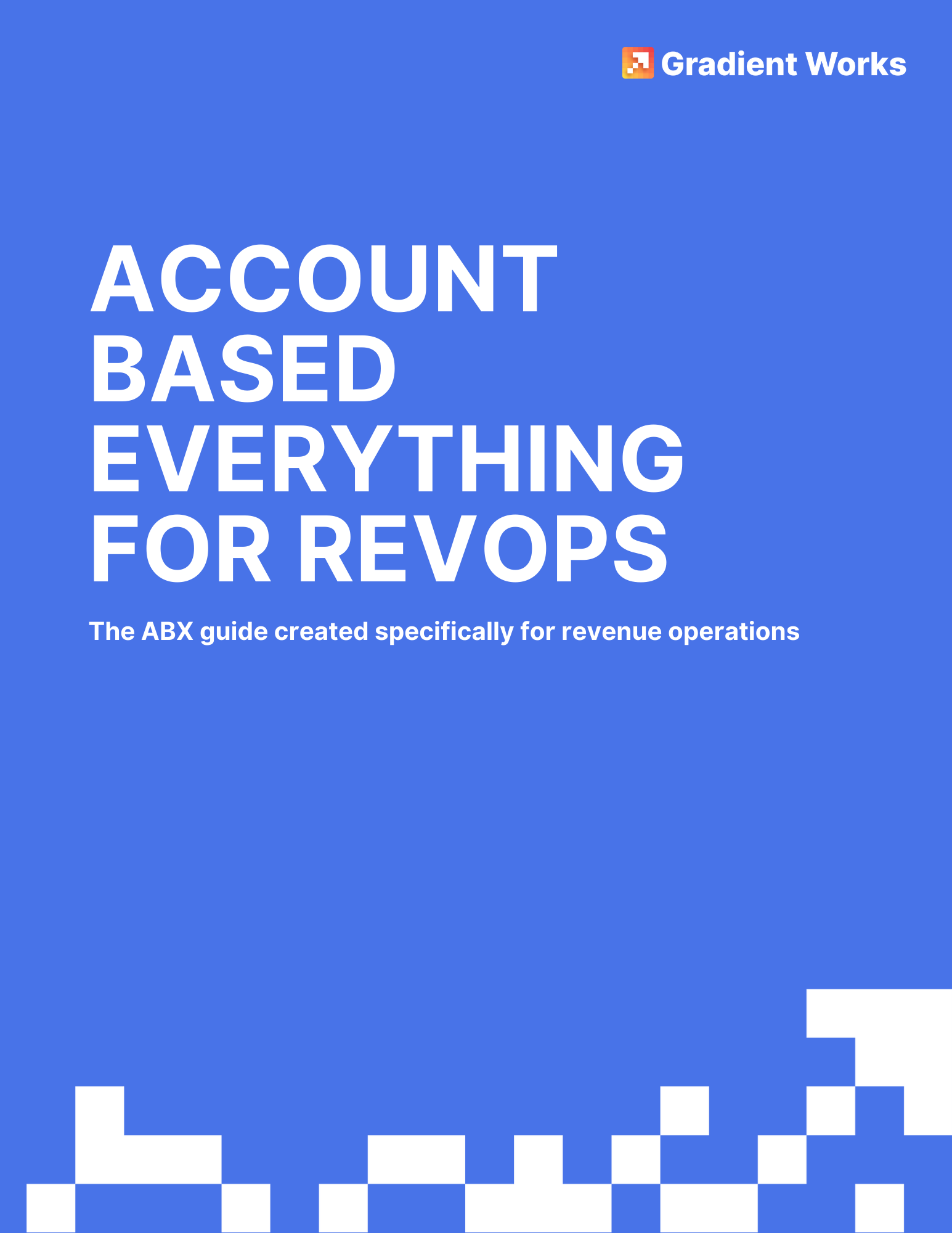Get your free guide to ABM and ABX for RevOps
Everything revenue operations needs to implement an ABX program across the revenue org
There’s a lot of ABM content for marketing teams. But what about the rest of the revenue organization? More companies are moving from a marketing-focused ABM model to a more company-wide ABX model, and RevOps is essential to the switch.
Download our free guide to account based everything, created for revenue operations teams by Gradient Works. This comprehensive guide includes discussion of:
- What is ABX vs. ABM vs. ABE
- ABX frameworks
- Rules of engagement and sales processes
- ABX tech stack
- Lead to account matching and assignment
- Implementing ABX in Salesforce
- And many more operational issues!
Read an excerpt from the guide
ABM vs. ABX
First, let’s discuss nomenclature. For years, we've called it “account based marketing” or ABM. But more recently, more and more people are using the ABX acronym. What's the difference?
Account based marketing (ABM) refers to high-level coordination between marketing and sales to gain or grow customers at the account level (and not the individual contact or lead level). With ABM, the idea is that the highest value B2B customers are companies, and to keep and grow a customer, you need to win an entire account, not just one or two people who work there. Historically, ABM was run out of the marketing department, and emphasized a more focused lead generation effort on a small group of target customers.
Account based experience (ABX), on the other hand, is essentially just a more modern way of referring to the same concept, that intentionally incorporates a full customer lifecycle view of an account - from marketing to sales and customer success and everything in between. It’s account based everything. Some people even use the ABE acronym. ABE/ABX takes a systems view of the revenue organization, and relies on true alignment and coordination between teams.
ABM has never really been just about marketing, which is why many companies use the more inclusive ABX and ABE acronyms. We’ll use ABX throughout this document, because we believe it’s philosophically more aligned to our view of the customer lifecycle.
Why ABX?
There are myriad reasons a company might move to an ABX model, but for many, they transition because the customer demands it. B2B buying has changed dramatically over the past 5-10 years. The typical B2B buyer comprises multiple stakeholders - at least 4 people, often up to 10 or more. It’s a complex sales process, with more buying interactions before a deal closes, buyers finding information everywhere (and definitely not just from the vendor), and multiple competitors involved in most deals. These changes in buying complexity mean companies need smarter, more sophisticated ways to sell. Enter ABX.
Let’s compare ABX to a more traditional transactional approach. In a transactional model, your job is to convince someone to purchase a product or service within a single sales cycle. You either win or you lose. ABX takes a broader view. You know which businesses should be your customers, so you engage them over time - often over multiple sales cycles. You tailor your messages to different folks within the account (the executives, the decision makers, the influencers) to ultimately build broad-based support for your solution. If you lose an individual sales cycle, you derive information you can use in future sales cycles. To use a sports metaphor, the transactional model is about winning an individual game, while ABM is about winning the championship over the course of a season.
This all sounds great; who doesn’t want to win championships? But there’s just one problem. Reps can’t talk to accounts. They talk to people. So when somebody goes to your website and fills out a lead form, you just need to assign that lead to a rep to go call them, right? If only it were so simple.
Gartner has a useful operational definition of ABX. Here are Gartner’s five attributes that define account based everything:
- Targeted, high-value accounts
- Data and intelligence-driven programs/campaigns
- Orchestration across marketing, sales development, sales and customer support
- Valuable and personalized buyer experiences
- Coordinated, high-frequency/effort outreach
We’ve created a similar framework for thinking about ABX, particular for companies making the transition from a lead-based GTM motion to a more account-based one.
- Accounts should be your focus, not leads.
- Clear rules of engagement are essential.
- Your CRM and workflows will need some updates.
- Change management will help.
- Marketing, sales and customer success need to be in lock step.
There are a few similarities across both frameworks, concepts that are both foundational to ABX and important for revenue operations. Let’s dig in.
Strategy. An effective ABX motion requires alignment between all customer-facing teams. There may be new specialized roles and there will definitely be new processes, both of which require careful change management. You’ll likely need to develop a new playbook for your rules of engagement that define how customers flow through your organization, and how teams work together for the best results.
Planning and process. If you’ve historically structured your sales organization around leads or patches, you’ll have a lot of work to do on account distribution. That will require orchestration in plays across teams, coordination in outreach and timing, new SLAs, and so on.
Technology. Naturally, new sales processes mean new sales technology. You may need to replace or add to your revenue tech stack to include more modern software for ABX management, like lead routing, account assignment, or sales process automation.
Download the full guide to read the rest!
Don't need a guide? How about new account distribution software?
Your current lead routing solution - whether it's an older lead routing tool or just a spreadsheet - probably doesn't give you the flexibility and agility you need to keep up with an ABX model. Maybe it's time to check out Gradient Works.

